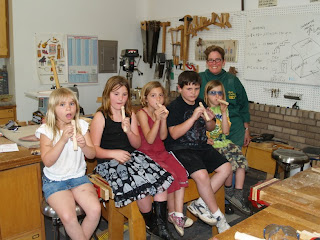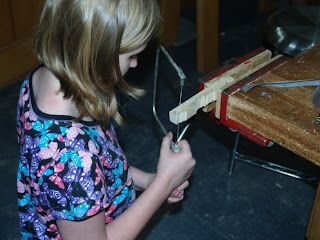"In many respects the organ of touch, as embodied in the hand, is the most wonderful of the senses. The organs of the other senses are passive; the organ of touch alone is active. The eye, the ear, and the nostril stand simply open: light, sound, and fragrance enter, and we are compelled to see, to hear, and to smell; but the hand selects what it shall touch, and touches what it pleases. It puts away from it the things which it hates, and beckons towards it the things which it desires unlike the eye, which must often gaze transfixed at horrible sights from which it cannot turn; and the ear, which cannot escape from the torture of discordant sounds and the nostril, which cannot protect itself from hateful odours.And so why do we not make deliberate use of our children's grasp of the world in their educations? Today we have an open house at the Clear Spring School and I will be set up with a work bench, some tools and children's work to explain to visitors, the strategic implementation of the hands.
Moreover, the hand cares not only for its own wants, but, when the other organs of the senses are rendered useless, takes their duties upon it. The hand of the blind man goes with him as an eye through the streets, and safely threads for him all the devious way: it looks for him at the faces of his friends, and tells him whose kindly features are gazing on him; it peruses books for him, and quickens the long hours by its silent readings. It ministers as willingly to the deaf; and when the tongue is dumb and the ear stopped, its fingers speak eloquently to the eye, and enable it to discharge the unwonted office of a listener.
The organs of all the other senses, also, even in their greatest perfection, are beholden to the hand for the enhancement and the exaltation of their powers. It constructs for the eye a copy of itself, and thus gives it a telescope with which to range among the stars; and by another copy on a slightly different plan, furnishes it with a microscope, and introduces it into a new world of wonders. It constructs for the ear the instruments by which it is educated, and sounds them in its hearing till its powers are trained to the full. It plucks for the nostril the flower which it longs to smell, and distills for it the fragrance which it covets. As for the tongue, if it had not the hand to serve it, it might abdicate its throne as the Lord of Taste. In short, the organ of touch is the minister of its sister senses, and, without any play of words, is the handmaid of them all.
And if the hand thus munificently serves the body, not less amply does it give expression to the genius and the wit, the courage and the affection, the will and the power of man. Put a sword into it, and it will fight for him; put a plough into it, and it will till for him; put a harp into it, and it will play for him; put a pencil into it, and it will paint for him; put a pen into it, and it will speak for him, plead for him, pray for him. What will it not do? What has it not done? A steam-engine is but a larger hand, made to extend its powers by the little hand of man! An electric telegraph is but a long pen for that little hand to write with! All our huge cannons and other weapons of war, with which we so effectually slay our brethren, are only Cain's hand made bigger, and stronger, and bloodier! What, moreover, is a ship, a railway, a lighthouse, or a palace? What, indeed, is a whole city, a whole continent of cities, all the cities of the globe, nay, the very globe itself, in so far as man has changed it, but the work of that giant hand, with which the human race, acting as one mighty man, has executed its will." --Dr. George Wilson on the Hand - 1856
"Boys ever delight in being occupied in something for the youthful blood does not allow them to be at rest. Now as this is very useful, it ought not to be restrained, but provision made that they may always have something to do." -Comenius.In other words, children's activities, their hands-on explorations, are a useful resources that educators should use, not waste, for in wasting their most natural inclinations, we damage them in ways only succeeding and preceding generations may understand.
Make, fix and create.













































